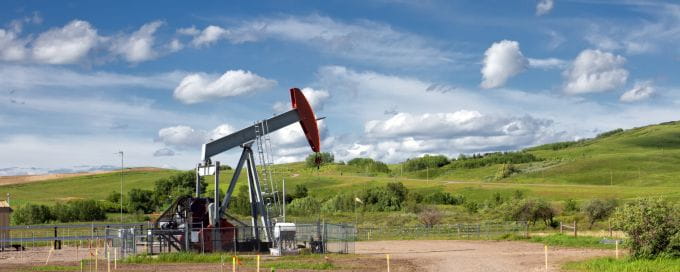
Why we measure this
The Government of Saskatchewan monitors greenhouse gas (GHG) emissions and related statistics to track our progress in achieving our commitment to action on climate change.
Saskatchewan's GHG emissions totalled 67.1 million tonnes of CO2e in 2021.
Measuring changes in GHG emissions and related activity is necessary for understanding the effectiveness of policies that build resilience to climate change and the interactions between climate change and the broader economy.
Much of our economy relies on the natural world, including agriculture, forestry, ecotourism and other resource-based industries. The success of these industries, and the province, depends on a stable climate and a resilient environment.
Saskatchewan's infrastructure was designed and built to operate within a range defined by historical norms. As the climate changes, we will experience weather outside of those norms, putting our infrastructure at risk of failing and increasing the likelihood of events like power failures and road washouts.
This measure discusses the effects of a changing climate on the province and economy, as well as government programs designed to address the impacts.
What is happening

Saskatchewan's GHG emissions declined significantly during the pandemic, falling 16 per cent from a peak of 77.1 metric tons in 2018 to 65.1 metric tons in 2020. Emissions rebounded slightly in 2021 to 67.1 metric tons. That same year Saskatchewan's GHG emissions constituted 10 per cent of Canada's total emissions. Canada, in turn, made up about 1.8 per cent of global GHG emissions. Carbon dioxide accounted for 70 per cent of Saskatchewan's GHG emissions. Other emissions sources included methane at 21 per cent, nitrous oxide (N2) at eight per cent and fluoridated gasses at less than one per cent.
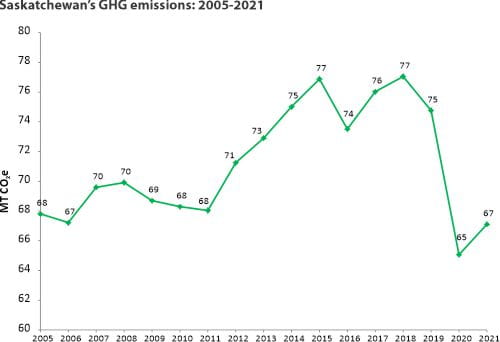
Most of Saskatchewan's GHG emissions come from oil and gas production, electricity generation and agriculture. Each of these activities make up about a quarter of the province's total GHG emissions. All remaining activities, such as transportation, heating buildings, construction, mining and others, are collectively responsible for the remaining quarter. In the oil and gas sector, emissions have fallen 40 per cent since their peak in 2015.
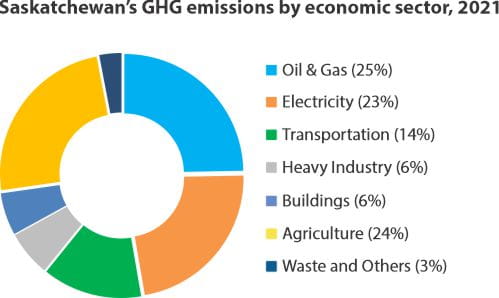
GHG emissions per dollar of gross domestic product (GDP), or the total amount of goods and services produced in an economy, is known as the GHG emission intensity. Saskatchewan's GHG emission intensity dropped 18 per cent since 2005. However, in 2021, the economy was still experiencing significant negative effects from the COVID-19 pandemic. It remains unclear what long-term effects the pandemic will have on GHG emissions or the economy.
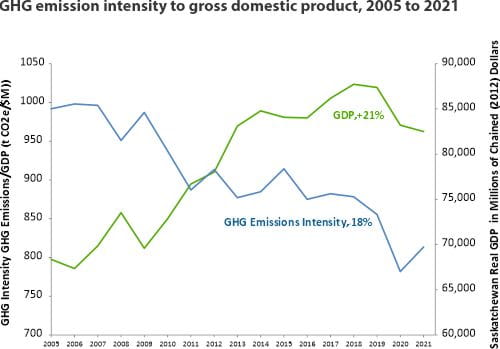
Saskatchewan has the fourth highest GHG emissions of the provinces after Alberta, Ontario and Quebec. Alberta and Manitoba saw their GHG emissions increase between 2005 and 2021, whereas all other provinces saw declines.
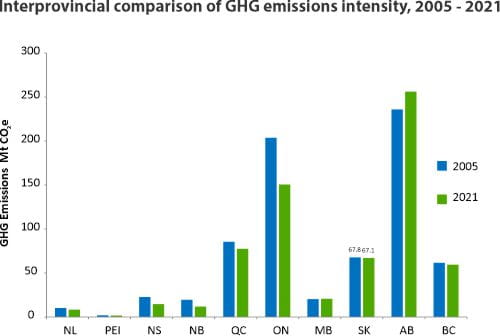
The latest research shows Saskatchewan is getting more rain, which may lead to more floods. At the same time, higher temperatures dry the ground faster, deepening the severity of droughts.
Higher temperatures are increasing the length of the growing season, but warmer winters are causing more problems with pests and invasive species. The mountain pine beetle has already destroyed forests in British Columbia and Alberta.
In some parts of the boreal forest, trees may start growing faster because of the longer growing season. Other parts of the boreal forest will naturally burn, and aspen parkland and grassland will grow in their place.
The type of crops and livestock that grow best will change with the climate.
What we are doing
At the COP-21 meeting in Paris in 2015, 195 countries, including Canada, agreed to reduce their GHG emissions in what is known as the Paris Agreement. Following the Paris Agreement, premiers and the Prime Minister met in Vancouver, where they signed the Vancouver Declaration, in which all provinces agreed to the national goal of reducing GHG emissions by 30 per cent below 2005 levels by 2030.
Following the Vancouver Declaration, Saskatchewan developed Prairie Resilience: A Made-in- Saskatchewan Climate Change Strategy, which is available at saskatchewan.ca/climate-change. Prairie Resilience is a strategy that takes a system-wide approach and includes more than 40 commitments designed to make Saskatchewan more resilient to the effects of a changing climate. The commitments – which go beyond emissions reductions alone – span Saskatchewan's natural systems and resources, infrastructure for electricity, transportation, homes and buildings, and community preparedness.
Prairie Resilience focuses the Province's efforts on specific industries and activities that could have the greatest impact on provincial GHG emissions.
SaskPower is committed to achieving net-zero by 2050. As work continues toward that goal, the province will maintain an energy mix that ensures reliable base load power and affordable rates for customers.
SaskPower also pioneered the development of carbon capture and storage (CCS) technology in 2014, which has since been used to capture more than five million tonnes of CO2. These efforts are expected to reduce emissions from electricity generation by half over the next decade.
Prairie Resilience also targets methane emissions in the oil and gas industry. About 60 per cent of GHG emissions in the industry come from the disposal of unwanted methane. In 2019, the Province introduced the Methane Action Plan, a Saskatchewan-made plan to reduce the amount of methane emissions. The plan was expected to reduce methane-related emissions by 40 to 45 per cent by 2025, but succeeded in reducing methane emissions by 60 per cent in the first three years.
Heavy industry and the oil and gas industry are subject to the output-based performance standards, also known as the OBPS Program. The standards require companies to reduce the emissions intensity of their operations. Upstream oil and gas producers and refineries are required to reduce their emissions intensity by 20 per cent on top of reductions required by methane regulations, while other industrial emitters are required to reduce their emission intensity by 15 per cent.
Saskatchewan is making efforts to reduce GHG emissions, but climate change requires collective global action. For this reason, the core principle of Prairie Resilience is resilience – the ability to cope with, adapt to and recover from stress and change. This is essential, as the effects of climate change are already being experienced.
The Province is tracking many initiatives for enhancing resilience – from forest management to culvert expansion and crop diversification to monitoring diseases. For a complete list, please refer to Saskatchewan's 2021 Climate Resilience Report.






